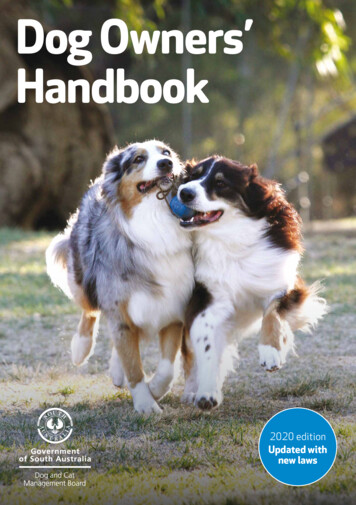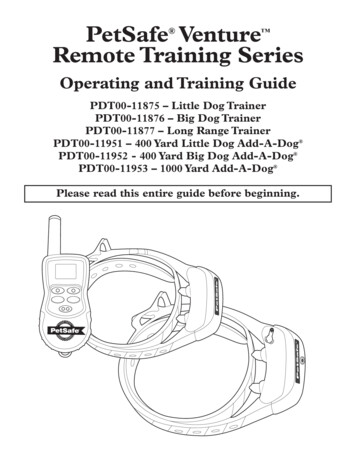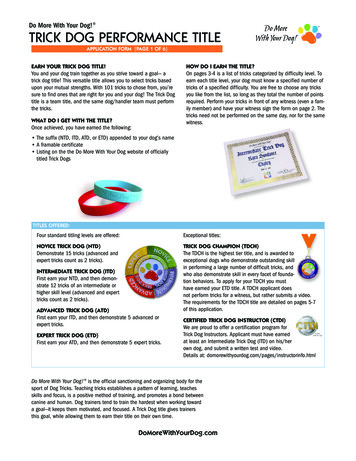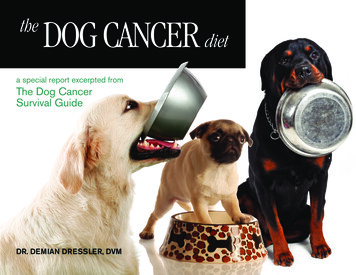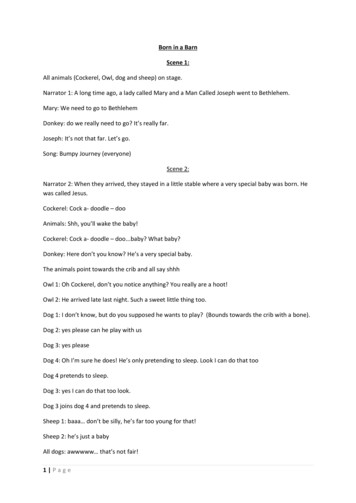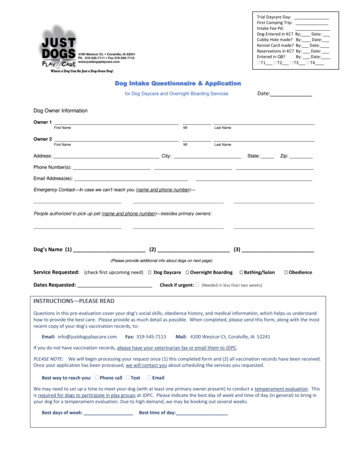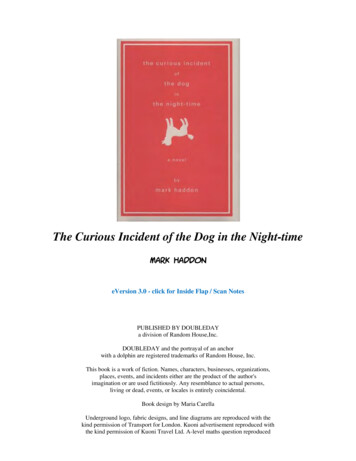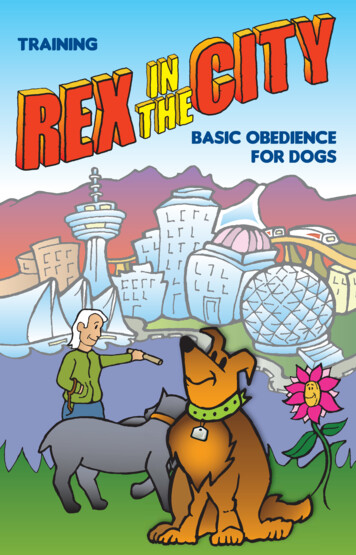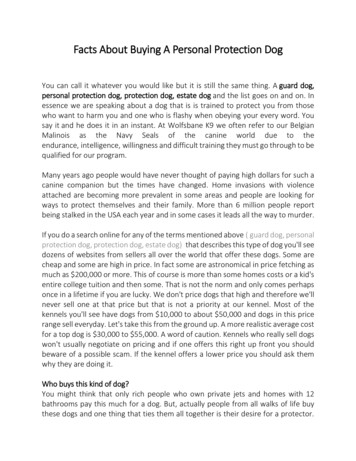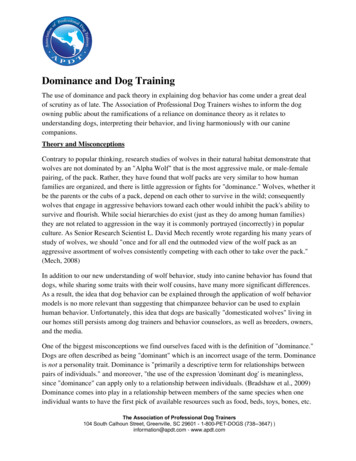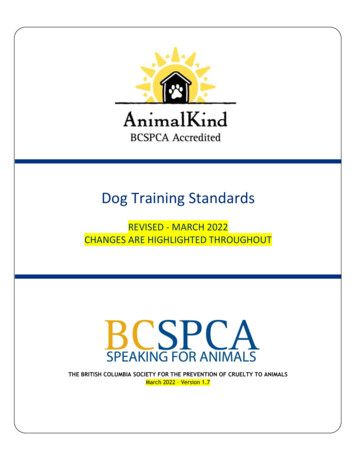
Transcription
Dog Care course files included in this file:Primary authors: Drs. Alice Huang and Joan Richerson
Lesson 1. Dog Care BasicsVA Dog Care CourseLesson 1. Dog Care Basics: Feeding,Exercise, and Basic HealthcareYou have been asked to take this course to help you get ready for a dog to beassigned to you for the research study you will be taking part in. The information inthis course is likely to be useful as you and your dog get to know each other, so youwill get a printed copy of everything to take home with you. Put it somewhere handyso you can look in it whenever you have questions about doing things with your dog.Feel free to share it with other people in your household and anyone else who may dothings regularly with you and your dog.This lesson goes over the basics of caring for a dog. You will find out about dognutrition and feeding, how to make sure your dog gets the exercise he or she needs,and what else you need to do to keep your dog healthy. These are basic to building asuccessful partnership with your dog, and this lesson is to help you understand what todo.Throughout this course, “your dog” may be referred to as either “he” or “she”. Thisdoes not mean that the parts that talk about “him” only apply to male dogs and theparts that talk about “her” only apply to female dogs. It’s just simpler than saying “heor she” each time, and is always intended to apply to your dog, regardless of whetheryou are assigned a male dog or a female dog.Remember that you are responsible for your dog’s care, but his VA trainer, hisveterinarian, and the entire study team are dedicated to helping you learn what youneed to do. If you have any questions, be sure to ask them for advice!During the study, almost all of the expenses of taking care of your dog will be coveredfor you. But after your part of the study is finished, the dog will become yours if youwant to keep him, and at that point, you will become responsible for all of the costs, sothis lesson also includes information about what it costs to care for a dog properly.As a final step before receiving a dog in the study, you will be tested on theinformation in all four lessons in this course. A VA dog trainer will go over the examwith you and explain any information that is not clear to you then.Learning Objectives for Lesson 1This lesson will help you to learn: What foods are healthy to feed to your dog, and what is not healthy for her toeat; How to make sure your dog is getting the right amount of exercise;Lesson 1: Page 1 of 17v2 9/17/15
Lesson 1. Dog Care Basics What else you should do to keep your dog healthy: Grooming and bathing Mouth care Nail care Keeping ears healthy How much it costs to take proper care of a dog.1.1 Diet, Feeding, and Nutrition 1-7A good diet is important for keeping your dog healthy and happy. It provides the rightproportions of the nutrients that your dog needs. She will be used to a good qualitykibble (dry food) when you get her. It will be best for her to keep on getting the same kindof food, so you will get a coupon for a free bag of it each month during the study. Giveyour dog one dish for food and a separate one for water. Clean the bowls each day,and make sure that there is always cool, fresh water in the water bowl.How often should I feed my dog?Find out from your dog’s vendor or the VA trainer when you receive the dog how manymeals a day he’s used to eating, and how much he gets each time, so you can start fromthere. The important thing is to watch your dog and adjust the amount of food you givehim, so that he maintains a good weight and stays healthy. The dogs in this study will befairly large (more than 40 lb.) healthy young adults, so most likely, 1 or 2 meals a daywill be about right. You may need to figure on giving your dog as much as a few cups ofkibble each day (give half the amount at each meal, if you feed 2 meals per day!). Thenutrition label on the food can also help you figure out a reasonable amount of food foryour dog’s weight and activity level. If you have any questions about this, check withyour dog’s veterinarian.What about other kinds of food?While you and your dog are participating in the study, we recommend that you use thefood that you get with the coupon, but you can feed other good-quality diets as well.Different kinds of dog food are designed for different stages of a dog’s life, frompuppyhood to senior years, so you may want to change the food as your dog getsolder.Look on the package of any food you consider feeding your dog, to see that it meetsthe standards of the Association of American Feed Control Officials 2 (you might see thiswritten as “AAFCO”) There are different categories of standards that the food canmeet, which can be confusing, so it may be helpful to ask your dog’s veterinarian forsuggestions.In general, kibble (dry food) is better for dogs than soft dog food is, for several reasons.Crunching the hard kibbles keeps your dog's teeth clean and exercises his jawmuscles. It also keeps his stools compact and firm, which makes them easier to cleanup. If your dog needs soft food some reason, you can mix some in with the kibble (trythree-quarters dry kibble with one-quarter canned moist food).Lesson 1: Page 2 of 17v2 9/17/15
Lesson 1. Dog Care BasicsWhatever food you choose, the most important thing is always for you to watch yourdog’s behavior and appearance carefully, because they will tell you whether the food isright for her. If your dog's energy level is right for her breed and age, if her skin andcoat are healthy, if her stools are firm and brown, and if she seems to be in overallgood health, then the food is doing its job.What about treats?Dogs enjoy occasional treats, just like humans do. Just remember to choose nutritioustreats, and include them when you figure out how much food you are feeding your dog!Just like humans, dogs can become obese if they get too many extra snacks or treats,so limit the number of treats you feed your dog. Also, remember that dogs enjoy a verysmall piece of a treat as much as they do a large treat with more calories, so when yougive treats, use small treats with fewer calories.Besides nutritious treats that are sold especially for dogs, dogs enjoyvegetables like broccoli, carrots, zucchini, cauliflower, peas, and beans, andfruits like bananas (peeled), apples, and melon (peeled) 1. Small amounts ofthese can be great low-calorie treats. Other foods that are good for humanscan actually be harmful for dogs. The next part of this lesson will tell aboutsome of those. The bottom line is that dogs have different nutritional needsthan humans do, so it will be best for your dog if you only give him food meantfor dogs (no matter how hard he begs for whatever you are eating!).Keeping food and treats safe and healthy 3Just as it’s important to handle and store food for humans carefully, to make sure it’swholesome and tasty when it’s served, the food and treats that you give your dogalso need to be handled and stored carefully. Make sure when you buy food for yourdog, that you choose a package that is clean and sealed, and then store the food theway the package recommends. It’s best to keep kibble in a cool, dry place. Leave itin the bag it came in, and put the opened bag inside of a large plastic container with acover.An extra problem to watch out for when you have a dog, is that some germs (likeSalmonella) may or may not make your dog sick, but your dog can still pass them onto you (or other people) and make the people sick, even when your dog is fine.When people get infected with Salmonella, they generally get diarrhea and stomachcramps, which can be severe enough to send them to the hospital. Salmonella canbe present in raw meat 4, bones, and eggs, as well as in the stools of infectedanimals. If you handle any contaminated foods or wastes, and then handle your dogor his food, you can pass the germs to your dog. Your dog can also get the germs bycontact with stools from infected animals. He can then spread them in his stools.The best way to stop the spread is for you to always wash your hands well with soapand water 5 before and after you handle your dog or your dog’s food, water, or waste.Dangerous for Dogs!Many things that you may have around your house can make your dog sick or even die.Some are foods that are perfectly okay for humans to eat (chocolate, avocados, onions,grapes, and spinach), and others are things you would never think of eating, but yourLesson 1: Page 3 of 17v2 9/17/15
Lesson 1. Dog Care Basicsdog could get into (bleach, deodorants, deodorizers, detergents, matches, and nailpolish). The table 6 on the next page was put together by the American Kennel Club(www.akc.org), and is a handy list of things to watch out for. There’s an extra copy of iton the following page, so you can put one on your refrigerator door if you like.Certain foods and householdproducts can be dangerous to dogs!It’s only natural for dogs to be curious. But, their curiosity can get them intotrouble when they get into areas where you store household items such asmedicine and detergents. Many common household items that you use everyday can be harmful, and sometimes even lethal, to your dog.Foods that are harmful toyour dog:Common household itemsthat are harmful to your dog:Acetaminophen (Tylenol )Antifreeze and other car fluidsBleach and cleaning fluidsBoric acidDeodorantsDeodorizersDetergentsDe-icing saltsMay cause varied reactions:DisinfectantsYeast doughDrain cleanersCoffee groundsFurniture polishMacadamia nutsGasolineTomato and potato leaves and stemsHair coloringsAvocadosWeed killersOnions and onion olateMothballsPear and peach kernelsNail polish and removerMushrooms (if also toxic to humans)PaintRhubarbPrescription and non-prescriptionmedicineSpinachRat poisonAlcoholRubbing alcoholShoe polishSleeping pillsSnail or slug baitTurpentineWindshield-wiper fluidSymptoms of possible poisoning are: vomiting, diarrhea, difficult breathing,abnormal urine (color, aroma or odor, frequency, etc.), salivation, weakness. Ifyour dog shows any of these symptoms, or you suspect that she has swallowedharmful chemicals, contact a veterinarian or poison control center immediately.May cause vomiting, abdominal painand/or diarrhea:Wild cherryAlmondApricotBalsam PearJapanese PlumLesson 1: Page 4 of 17v2 9/17/15
Lesson 1. Dog Care BasicsCertain foods and householdproducts can be dangerous to dogs!It’s only natural for dogs to be curious. But, their curiosity can get them intotrouble when they get into areas where you store household items such asmedicine and detergents. Many common household items that you use everyday can be harmful, and sometimes even lethal, to your dog.Foods that are harmful to yourCommon household items thatdog:are harmful to your dog:May cause vomiting, abdominal painand/or diarrhea:Wild cherryAlmondApricotBalsam PearJapanese PlumMay cause varied reactions:Yeast doughCoffee groundsMacadamia nutsTomato and potato leaves and stemsAvocadosOnions and onion powderGrapesRaisinsChocolatePear and peach kernelsMushrooms (if also toxic to humans)RhubarbSpinachAlcoholAcetaminophen (Tylenol )Antifreeze and other car fluidsBleach and cleaning fluidsBoric acidDeodorantsDeodorizersDetergentsDe-icing saltsDisinfectantsDrain cleanersFurniture polishGasolineHair coloringsWeed killersInsecticidesKeroseneMatchesMothballsNail polish and removerPaintPrescription and non-prescriptionmedicineRat poisonRubbing alcoholShoe polishSleeping pillsSnail or slug baitTurpentineWindshield-wiper fluidSymptoms of possible poisoning are: vomiting, diarrhea, difficult breathing,abnormal urine (color, aroma or odor, frequency, etc.), salivation, weakness. Ifyour dog shows any of these symptoms, or you suspect that she has swallowedharmful chemicals, contact a veterinarian or poison control center immediately.Lesson 1: Page 5 of 17v2 9/17/15
Lesson 1. Dog Care BasicsAre Bones OK?It’s tricky to select and prepare bones that are safe for your dog. The wrong kind ofbones can make your dog sick, or injure the stomach or gut with splinters or sharpedges, so it is easiest if you just don’t give him any bones. Fortunately, there are plentyof other options that your dog can enjoy just as much. You may want to discuss withhis veterinarian which specific chew toys are best for him.1.2 Exercise 7, 15Why is exercise important? 8Dogs need exercise to stay healthy and happy. They enjoy being mentally and physicallyactive, and they are social animals. This means that when your dog gets to do things withyou for exercise, it’s a WIN-WIN-WIN situation! It can be a lot of fun for both of you, it’sgreat for your dog’s health, and it makes it less likely that she will misbehave.Just like for humans, the health benefits of exercise include helping to: keep your dog agile and limberkeep his digestive system working well (preventing constipation andother problems)make her feel sleepy rather than restless, when it’s time to be quietmaintain healthy weightExercise also encourages good behavior. Dogs who are bored or who don’t getto use up enough of their energy exercising are more likely to misbehave and dothings like: Destroy property by chewing, digging or scratchingBe hyperactive and excitable, and have a hard time settling down at nightKnock over furnitureJump up on peoplePlay too roughlyBark and whine for attentionHow much exercise does my dog need?The dogs in this study will all be healthy young adults of generally active breeds, soyou should figure on giving your dog at least 30 minutes of vigorous exercise daily, oran hour or two of ordinary everyday activities.9 Your dog’s vendor or VA trainer will tellyou when you get your dog what routine he’s used to.There are lots of things you can do to make sure your dog gets the exercise sheneeds. You can choose activities for you and your dog to exercise together, but thereare also ways to exercise your dog when your dog needs more exercise than you areup for. The most important thing is to choose activities that you and your dog bothenjoy.Lesson 1: Page 6 of 17v2 9/17/15
Lesson 1. Dog Care Basics1.2.1. If Your Dog Needs More Exercise Than You Want 8-10Some activities keep your dog busy even if you don’t want to exercise with him.Give your dog interesting things to pay attention to. Food puzzle toys can be a greatway to keep him active. Just make sure to count the food he gets from the toy as partof the food he gets for the day! Obedience training and teaching your dog to do trickscan also be fun for both of you, and will give your dog both a brain workout and somephysical activity. Playing with a chew toy is another kind of healthy physical activity thatyour dog will probably find interesting.Besides activities like these, which can satisfy your dog’s need for mental activity, she willalso still need some additional physical activity. You can help her get it with gamesthat give her reasons to run around while you mostly stand or sit still These include“fetch” with a ball or Frisbee, Hide-and-Seek, catching bubbles, and chase (a toy on arope).Even though many dogs seem to like to play with sticks, this is really quite dangerous,so don’t let your dog do it. Dogs often get badly injured when they run too eagerly intothe end of a stick they are chasing. (The stick can puncture a dog’s eye, mouth, chest,abdomen, and even skull!). Even chewing on sticks is dangerous because splintersget caught in the tongue or gums. Splinters also irritate or injure the gut if they getswallowed, and can cause infection or make it hard for your dog to breathe if they getinhaled 10.1.2.2. Exercise for You and You Dog Together 8 - 11On-leash walking and joggingGoing for a walk can be good exercise for both of you, and also gives your dog moreterritory to sniff and explore. Use a leash that is about 6-8 feet long, so that he staysclose to you, and take different routes every now and then, for variety.A brisk 30 minute walk with your dog will give you each a healthy dose of exercise, but ifeither of you is out of shape, start with less and work your way up. Your dog’s vendor orVA trainer can tell you when you receive her, what she is used to. If you like to jog, and youwant your dog to jog along with you on a leash, just make sure you pay attention to howshe responds, so you don’t make her overdo. If she behaves like you feel when you’vedone too much, it was probably too much for her, so try a little less (slower or shorter, orboth) next time. Check her paws for blisters afterward, rinse off any salt (if there was saltsprinkled on your route to melt ice) and dry off any water, snow, or ice.Exercise on a leash may be all that some smaller, older, or unathletic dogs need, butthe dogs in this study will be healthy young adults, about two years old, so be sure togive your dog chances to exercise without a leash as well.Lesson 1: Page 7 of 17v2 9/17/15
Lesson 1. Dog Care BasicsOff-leash exerciseBeing off the leash lets your dog do what he feels like, when he feels like it – run likethe wind, stop to sniff something interesting, go off in a different direction on a whim.To keep your dog safe, make sure you let him do this only when he’s in a fenced-inyard, or in your home.1.2.3. Dogs, Play, and Public Health 5, 12, 13Dog parks can be great places for your dog to get off-leash exercise, and there’s theadded bonus of other dogs to play with as well. Your dog can also make friends withother dogs if you take training classes or just get together informally with other peoplewith dogs. Just like when groups of people get together though, like in schools, atwork, and at parties, there are more chances of getting sick when dogs get together.Diseases spread more easily among dogs than among humans because dogs tend tohave more direct physical contact with each other, they share bowls, toys, andequipment, and they are more likely to get exposed to insects, and contaminated water andstools. There also diseases that people can catch from dogs. And of course, there’san increased risk of dog bites when people and dogs get together. This doesn’t meanyou should avoid getting together with other people and their dogs, but it is worthwhileto know what to watch out for and how to reduce your risks.Common symptoms in dogs that are sick include: FeverRespiratory symptoms like a snotty nose, or more than occasionalsneezing or coughingStomach upset, including vomiting or diarrheaLooking malnourishedNoticeable external parasites, like ticks or fleasPatchy fur, fur loss in a single area, or crusty skin soresIf your dog has any of these symptoms, keep him away from other dogs, and take himto his veterinarian right away, so that he can be treated to get well again, if needed.Also, let the study team know promptly if your dog is sick. The cost of your dog’s visitsto the veterinarian will be covered by insurance while you are participating in thestudy, so you won’t need to worry about the veterinarian’s fees. Watch out for thesesymptoms in other dogs too, so that you can avoid letting your dog catch anythingfrom them.Common symptoms of diseases that humans can catch from dogs include: FeverRespiratory symptoms, like runny nose, or lots of sneezing or coughing,Stomach upset, including vomiting, or diarrheaExternal parasites, such as ticksSkin soresAvoid letting your dog have contact with stool from other dogs, and be careful toLesson 1: Page 8 of 17v2 9/17/15
Lesson 1. Dog Care Basicscollect your dog’s stools promptly and dispose of them properly 13. Always wash yourhands as soon as you can after you do so. Also wash your hands frequently whenyou take your dog to any gathering where you interact with other dogs. This canreduce the chances of spreading or catching anything from the other dogs 5. If youdo get sick yourself or think you have been exposed to a sick dog, see your owndoctor right away. Let your doctor know if your dog is being treated for anything, andbe sure to tell your doctor that you have a dog. Also let the study team know promptlyif you (or anyone else in your household) catch something from your dog.1.4 Dog Hygiene1.4.1 Grooming and bathing 7, 14 - 21Just like humans, dogs need their hair (or fur!) brushed and they need to be bathed.Brushing helps to remove dirt, debris, loose hairs and tangles. It also distributesnatural skin oils along the hairs for a healthy coat, and it gives you a chance to checkfor ticks and fleas. Be gentle and make sure that it’s a pleasant experience for yourdog, so you can do it easily.How often your dog needs to be brushed depends on what kind of coat she has, andwhat she has gotten into lately. Your dog’s vendor or VA trainer can tell you when youget your dog, what brushing routine she is used to, but the bottom line is always tobrush often enough to keep her coat clean and looking healthy. Many dogs lovegetting brushed, so you can do it much more than the minimum, but here’s a roughidea of what you can expect. There are three breeds of dogs that will be involved inthis study, Labrador Retrievers (Labs), German Shepherds (GSDs), and GoldenRetrievers (Goldens). If your dog is a Lab, he has a “low-maintenance waterproof coat” 15.which means that brushing once or twice a week will probably beenough. 16,17 If your dog is a German Shepherd, she has a “dense, medium-long coat”that tends to shed al lot 18, especially in the spring and fall, so you’ll needto brush her often. When she’s shedding, brush often enough to keepthe loose hair under control. The rest of the year, once a week willprobably do the job. 19 If your dog is a Golden, he has longer hair, which will need brushingabout twice a week 20 or even daily 21.Dogs don’t need baths as often as humans do, and getting a bath too often can evendry out the skin and coat. As a rule of thumb, figure on giving your dog a bath onlywhen he is dirty or smells bad, which can be as little as once every 2-3 months 14.Check with your dog’s vendor or VA trainer when you get your dog, to find out what heis used to.Lesson 1: Page 9 of 17v2 9/17/15
Lesson 1. Dog Care BasicsYou can find detailed instructions about brushing and bathing a dog r-dog .1.4.2 Mouth Care 7, 22 - 24Chewing on kibble, dog biscuits, and chew toys helps to keep your dog’s teeth clean,but may not be enough to keep plaque and tartar from building up. The accumulationof plaque and tartar can lead to problems with your dog’s gums and other tissues inher mouth and jaw. Pay attention to your dog’s mouth, and check with yourveterinarian if you notice any of the following: Gums that are red, swollen, or bleedingTeeth that are brownishReally disgusting breath (not just ordinary “dog breath”)Your dog keeps pawing at or rubbing his face or mouthYour dog tries to avoid hard foodsYour veterinarian can tell you what kind of dental routine she needs, and how toperform it. Your veterinarian will also advise you if your dog needs anything more.1.4.3. Nail Care 14, 25 - 27Just like your own nails, if your dog’s nails get too long, they can break, which can bepainful and get infected. They can also push her toes into unnatural positions, which willmake it harder for her to walk or run. This is not a problem for most dogs, because thenails tend to wear down naturally as they run around. Keep an eye on your dog’s nails,and ask your dog’s VA trainer or veterinarian for advice if they look like they arecatching on things, or pushing her toes to the side. If your dog needs her nails clipped,you can ask the veterinarian to do it, or you can learn to do it yourself, with specialclippers made just for dogs.1.4.4. Keeping Your Dog’s Ears Healthy 28 - 30The twists and turns inside of a dog’s ears can be a great place for dirt or wax to collectand for germs to grow, so check on your dog’s ears regularly (every couple of weeks).The insides should look clean and pink, so check with your veterinarian if you noticeany of the following: Discharge (might look like coffee grounds)Bad smells,Redness, swelling, ears feel unusually hot, or seem to hurt when youtouch themCrusty skinYour dog is tilting or shaking his head, pawing at his ears, or circling toone sideLesson 1: Page 10 of 17v2 9/17/15
Lesson 1. Dog Care BasicsYou can clean your dog’s ears (just the parts that you can see easily) by wiping themwith a cotton ball or a soft cloth wrapped around your finger. Dampen the cotton orcloth with some canine ear cleaning solution that you can get at a pet store. Don’tpush anything into the ear canal.1.5 The Costs of Taking Care of a Dog 31While you are enrolled in the study, you will get a monthly coupon for food, and a monthlyallowance to cover other costs of taking care of your dog. VA has purchased healthinsurance for your dog’s health care costs, so you also won’t have any out-of-pocketexpenses for her veterinary care either, while you and she are participating in thisstudy. After you and your dog finish your part in the study, you will become responsiblefor all of the future costs of taking care of your dog if you choose to keep her, so it’s veryimportant for you to budget for them. Although there are VA benefits that can cover someof the expenses for Service Dogs that help Veterans with hearing, visual, or mobilityimpairments, Service Dogs and Emotional Support Dogs for Veterans with PTSD are notcovered right now. This is because it is not known yet whether Service Dogs or EmotionalSupport Dogs actually help people with PTSD to manage the effects of the PTSD 32, andthat’s exactly why VA is doing this study.Below is a list of costs that you should be prepared to pay when you are no longerparticipating in the study. The amounts are based on an informal survey conducted bythe American Kennel Club in 2004. They collected responses from about 1000 dogowners. The numbers here have been adjusted for inflation to 2014 dollars.ANNUAL EXPENSESFood (about 1 bag of dog food per month) – the average shown is forordinary food. Premium food can cost as much as 50% moreRoutine veterinary care, including check-ups, shots, etc.Toys and treatsGroomingTravelAVERAGEREPORTEDTotal per year 562 533 273 239 352 1959Sometimes a dog will need emergency veterinary care or surgery, and you’ll want to beprepared to pay for it if your dog does need it. How much it will cost of course dependson exactly what is needed, but the owners surveyed reported spending an average of 795 each time it was needed.This is the end of Lesson 1. Now take the quizquestions after the Reference pages below andcheck your knowledge.Lesson 1: Page 11 of 17v2 9/17/15
Lesson 1. Dog Care BasicsReferences1. “Nutrition & Feeding.” akc.org. American Kennel Club, n.d. Web. 5 Dec 2014. http://www.akc.org/public education/nutrition feeding.cfm .2. “The Business of Pet Food – Labeling & Labeling Requirements.”petfood.aafco.org. Association of American Feed Control Officials, n.d. Web 5 Dec2014. nts.aspx .3. “Pet Food and Treats – Tips for Keeping People and Pets Healthy and Safe fromSalmonella.” cdc.gov. Centers for Disease Control and Prevention, 3 Sep 2013. Web.5 Dec 2014. http://www.cdc.gov/features/salmonelladrypetfood/ .4. Weese, JScott and J Rousseau. “Survival of Salmonella Copenhagen in foodbowls following contamination with experimentally inoculated raw meat: Effects oftime, cleaning, and disinfection.” The Canadian Veterinary Journal, 47.9 (2006): 887889. ncbi.nlm.nih.gov. National Center for Biotechnology Information. Web. 5 Dec2014. 4/ .5. Osborne, Malinda. “Hand washing key disease prevention measure not alwayspracticed – November 1, 2008.” avma.org. American Veterinary Medical Association, 15Oct 2008. Web. 5 Dec 2014. aspx 6. “Certain foods and household products can be dangerous to dogs!” images.akc.org.American Kennel Club, n.d. Web. 5 Dec 2014. http://images.akc.org/pdf/public education/dangerous products.pdf .7. “Tips on Basic Care for your Dog.” images.akc.org. American Kennel Club, n.d.Web. 5 Dec 2014. http://images.akc.org/pdf/public education/tips on basic care.pdf .8. .”Exercise for Dogs.” aspca.org. American Society for the Prevention of Cruelty toAnimals, n.d. Web.5 Dec 2014. st/dog-behavior/exercise-dogs .9. “Exercising with Your Dog 101.” m.petmd.com. PetMD, 5 Sep 2012. Web. 5 Dec2014. http://m.petmd.com/dog/wellness/evr dg exercising with your dog101 .10. Nicholas, Jason. “Why You Shouldn’t Let Your Dog Fetch or Chew Sticks.”pawnation.com. AOL Inc, 14 June 2013. Web. 5 Dec 2014. n-t-let-your-dog-fetch-orchew-sticks .11. Winter Care Tips. images.akc.org. American Kennel Club, n.d. Web. 5 Dec 2014. http://images.akc.org/pdf/press center/Winter Care Tips.pdf .12. “Dogs’ Social Lives and Disease Risks - Tips for Canine and Human Safety.”avma.org. American Veterinary Medical Association, n.d. Web. 5 Dec 2014. al-Lives-and-DiseaseLesson 1: Page 12 of 17v2 9/17/15
Lesson 1. Dog Care BasicsRisks.aspx .13. “Common sense measures to protect your dogs, yourself and others.” avam.org.American Veterinary Medical Association, n.d. Web. 8 Dec 2014. Your-Dogs-Yourself-andOthers.aspx .14. “Groom Your Dog.” aspca.org. American Society for the Prevention of Cruelty toAnimals, n.d. Web. 5 Dec 2014. og .15. “Labrador Retriever.” woofipedia.com. American Kennel Club, n.d. Web. 16 Dec2014. -retriever .16. Walton, Joel and Eve Adamson. “How to Groom a Labrador Retriever.” LabradorRetrievers for Dummies. N.p. John Wiley & Sons, Inc., 2000. dummies.com. Web. 16Dec 2014.
Shoe polish . Sleeping pills . Snail or slug bait . Turpentine . Windshield-wiper fluid Symptoms of possible poisoning are: vomiting, diarrhea, difficult breathing, abnormal urine (color, aroma or odor, frequency, etc.), salivation, weakness. If your dog shows any
